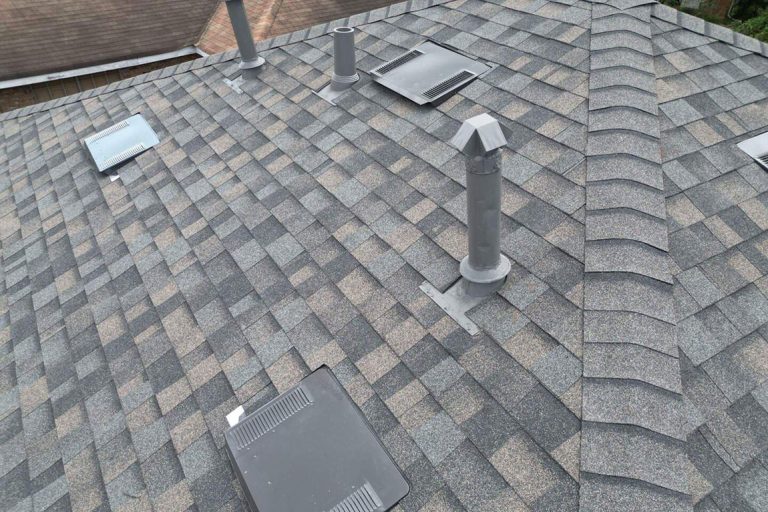The roof of a home serves a dual purpose. Beyond its functional role in providing protection against the elements, it also holds a prominent aesthetic significance, influencing the overall visual appeal of the house. The selection of an appropriate roofing material holds pivotal importance due to its impact on factors such as durability, energy efficiency, upkeep demands, and the overall curb appeal of your residence. Within this guide, we will delve into a diverse range of roofing materials, shedding light on their advantages, disadvantages, and appropriateness for varying surroundings and architectural designs.
1. Asphalt Shingles
Pros: It is widely accessible, cost-efficient, simple to install, and offers an array of styles and colors, making it compatible with diverse climates.
Cons: Not as durable as some other materials, may require more maintenance over time.
Asphalt shingles stand as one of the prevailing choices for roofing materials in the United States. This category presents itself in two distinct types: organic and fiberglass. Organic shingles are crafted from repurposed felt paper that is saturated with asphalt, while fiberglass shingles encompass a fiberglass mat layer ensconced between asphalt strata. Their versatility is underscored by their affordability and capacity to harmonize with an extensive spectrum of architectural styles.
2. Metal Roofing
Pros: Durable, energy-efficient, recyclable, fire-resistant, comes in various styles and colors, suitable for different climates.
Cons: Higher upfront cost, may require professional installation.
Metal roofing materials, including steel, aluminum, and copper, have surged in popularity due to their enduring nature and contemporary aesthetic. Characterized by their exceptional durability, they can endure for multiple decades with minimal upkeep requirements. Metal roofs reflect sunlight, reducing heat absorption and thus lowering energy bills. Additionally, they are environmentally friendly due to their recyclability.
3. Clay and Concrete Tiles
Pros: Durable, fire-resistant, excellent insulation, distinctive appearance, long lifespan.
Cons: Heavy, expensive, may require additional structural support, suitable for specific architectural styles.
Clay and concrete tiles present a distinctive and refined aesthetic often linked with Mediterranean and Spanish architectural themes. Renowned for their durability, they possess a remarkable ability to withstand challenging weather conditions, rendering them particularly suitable for regions susceptible to hurricanes or strong winds. However, their weight can be a concern, necessitating a sturdy roof structure.
4. Wood Shakes and Shingles
Pros: Natural appearance, good insulation, can last a long time with proper maintenance.
Cons: Prone to fire (unless treated), may require regular maintenance, susceptible to decay and insect damage.
Wood shakes and shingles provide a rustic charm that complements traditional and cottage-style homes. Although wood offers natural insulation, it demands a higher level of maintenance compared to alternative materials to fend off rot and maintain its optimal appearance. Notably, certain regions enforce building codes that limit the utilization of wood roofing due to its susceptibility to fire hazards.
5. Slate Roofing
Pros: Exceptionally durable, fire-resistant, elegant appearance, long-lasting.
Cons: Very heavy, expensive, requires specialized installation, suitable for specific architectural styles.
Slate roofing is renowned for its distinctive and sophisticated appearance. It is a natural stone material that offers remarkable longevity, with some slate roofs lasting over a century. However, due to its weight, proper structural support is crucial, and installation requires skilled professionals. The initial cost can be high, but the long lifespan can offset this expense over time.
6. Synthetic Roofing Materials
Pros: Mimics the look of natural materials, lightweight, durable, cost-effective.
Cons: Quality can vary, may not have the same longevity as natural materials.
Synthetic roofing materials, such as synthetic slate or composite shingles, imitate the appearance of more expensive natural materials while offering the benefits of lightweight construction and ease of installation. They can be a great compromise for achieving a desired aesthetic without the associated costs and maintenance requirements.
Choosing the right roofing material involves considering factors like climate, architectural style, budget, and maintenance preferences. Prior to making a decision, it is advisable to seek guidance from roofing experts and undertake comprehensive research. It’s crucial to bear in mind that a thoughtfully selected roofing material not only elevates the safeguarding of your dwelling but also adds to its overall allure and value.

